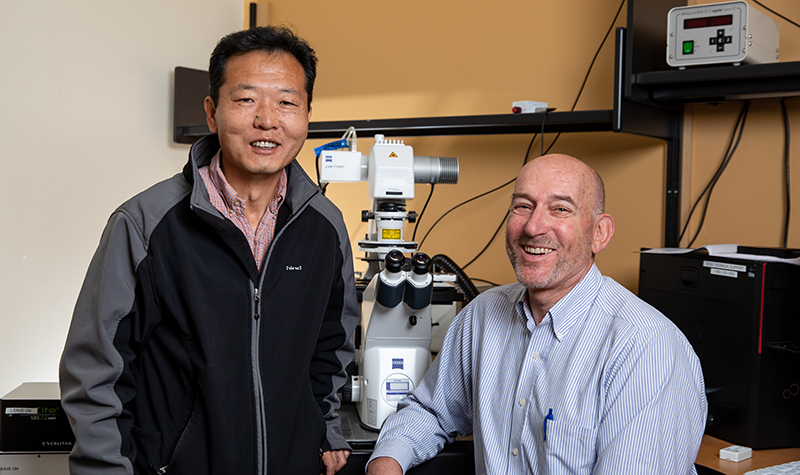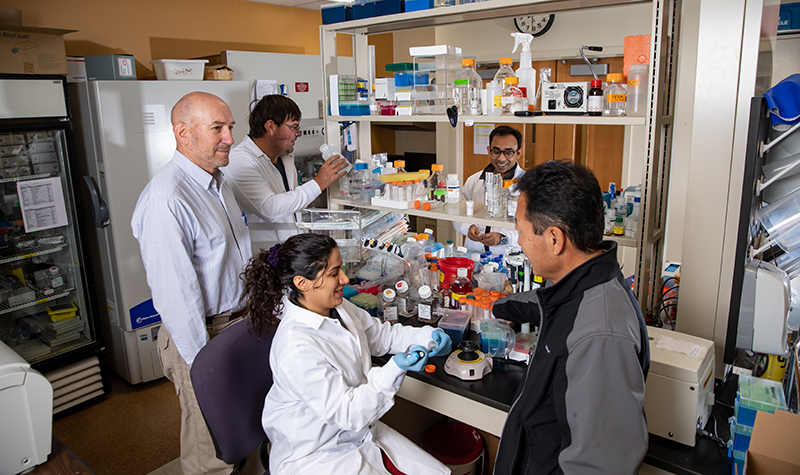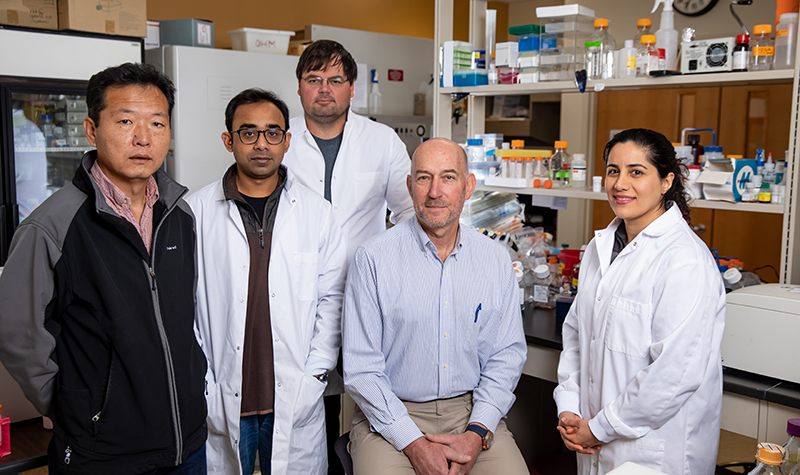13 Oct UND SMHS researchers net record series of NIH grants
Latest grant brings total to $7.5 million; research targets cognitive complications

UND neuroscientists Jonathan Geiger (right) and Xuesong Chen have received more than $7.5 million in research grants over the past five years, which is more than any other scientist has received in North Dakota history. Photo by Mike Hess/UND Today.
Five NIH R01 grants. $7.5 million.
Here’s why those numbers matter for UND.
Over the past five years, UND neuroscientists Jonathan Geiger and Xuesong Chen have received more than $7.5 million in research grants from the National Institutes of Health (NIH). That’s more NIH individual grant money received than any other scientist in North Dakota – ever.
Geiger, Chester Fritz Distinguished Professor in the Department of Biomedical Sciences at the School of Medicine & Health Sciences, and Xuesong Chen, associate professor in the same department, just received a $2.2 million R01 grant from the National Institute of Mental Health, a division of the NIH, to determine the mechanisms that may cause neurological complications in people living with HIV.
The award is even more remarkable because Geiger and Chen now have five active NIH R01 grants between them — three from the National Institute of Mental Health, one from the National Institute of Neurological Diseases and Stroke, and one from the National Institute of Drug Abuse. That accomplishment is unique in the state.

The $2.2 million is a testament not only to Geiger and Chen’s skills as scientists, but to UND’s ability to compete for grants at the most competitive levels. Their work is helping Goal 4 of the One UND Strategic Plan: enhancing discovery. Photo by Mike Hess/UND Today.
Competitive funding
And besides testifying to Geiger and Chen’s skills as scientists, this award and its predecessors play a vital institutional role as well. The reason is that NIH R01 grants are some of the most prestigious grants researchers can receive, and funding is extremely competitive.
Netting more of those grants is one of the goals of the One UND Strategic Plan (Goal 4, enhancing discovery), with a special focus on helping UND advance to the status of a research-intensive university (Carnegie R1).
“We can do it at UND,” said Geiger, Chester Fritz Distinguished Professor of Biomedical Sciences at the School of Medicine & Health Sciences.
“We have the people and the physical infrastructure to compete for grants. They are hard to get, and you bet they are hard work. But we can do it. Investigators at UND can compete with anybody.”
Only the top 10 to 20 percent of NIH grant applications are funded, said Geiger. But only 50 percent of applications are even reviewed in detail and scored. That means that just the top 5 to 10 percent of submitted grants get funding.
“It’s not easy,” Geiger said.
He should know. He just finished chairing two separate grant review study sections for the NIH, and continues to serve on other study sections.
“I get more nervous reviewing grants than writing them,” Geiger said. “I know how hard it is to get grants, and I want to do a good job. I know how much effort people put into writing grants.”
Submitting a grant can take years, said Chen.
“You have to gather a lot of preliminary data,” said Chen. “You need evidence to support your idea, and that takes a lot of time.”
“We have to generate those preliminary data to convince reviewers you have a good idea and we’re the right people to investigate it,” Geiger said.
And they always keep the big picture in mind.
“We remind our trainees that this is our tax dollars at work. We are cognizant of the public trust as we work to advance research.”
Geiger and Chen work together on multiple projects, and Geiger also works with researchers at other universities. Their work includes investigations into ketogenic diets and epileptic seizures, how dysfunction of lysosomes (organelles that digest particles) dysfunction affects persons with Alzheimer’s and HIV, how calcium functions in lysosomes, and how caffeine may protect against neurodegenerative disorders.

Geiger and Chen emphasized that they don’t do their top-level research in isolation. They have undergraduate, graduate, medical and post-doctoral students in the lab as they advance their understanding of cognitive disorders. Photo by Mike Hess/UND Today.
Solving problems
The one thing all his research has in common, said Geiger, is intellectual curiosity.
“The link between many of our interests is ATP [adenosine triphosphate], the universal energy source for cells,” Geiger said. “We’ve been studying ATP and its root compound adenosine for a long time, and are still interested in it. It’s known that caffeine can block cell-surface adenosine receptors, and caffeine can kick calcium out of cells. Another scientist asked me to collaborate on the link between a protein component of HIV and calcium. It’s easy to look back and see how it all ended up fitting together.”
Geiger and Chen emphasized that they don’t do their work in isolation.
They have a great group of people working with us in the laboratory, they said.
“We have undergraduate students, graduate students, medical students, and post-doctoral students. They’re really talented, and they come to us.”
With their most recent award, Chen and Geiger are seeking to test a strategy to prevent cognitive disorders in people treated for HIV.
“Earlier in the HIV pandemic, 20 percent of HIV patients developed dementia,” Chen said. “Now, after the introduction of effective antiretroviral therapies, their neurological complications, although less severe, are being experienced with increased prevalence; 30 to 50 percent of people living with HIV develop cognitive disorders.”
In describing their research, they liken the actions of the intracellular organelles — structures within living cells — that they study to the concept of digestion.
“We all eat,” said Chen. “The stomach is acidic, and without that acid, we can’t digest food. That lack of acid can also lead to infections and bacteria. The same thing happens to acidic organelles in cells, which need to eat and digest nutrients. If a virus can escape digestion from these acidic organelles, it can infect cells.”
“How do viruses and viral proteins escape from the organelles?” asked Geiger. “How does it get out of the organelles and replicate? No one knows the mechanisms, but we think we have a good theory. The NIH is letting us test those hypotheses.”
“We think the virus proteins escape through pores and channels that actually function to make the organelle acidic, just like the stomach pumps acid,” Chen continued. “That pump, disassembled, forms a big pore.”
Chen and Geiger said the pore may then open, allowing HIV proteins to escape from the lysosomes and end up in the nucleus where it can increase HIV replication.
“If that little lysosome stomach doesn’t work, all the waste accumulates in the neurons,” Chen said. “The neurons live as long as you do, and relatively few neurons in brain are capable of regenerating. If they can’t digest nutrients, they starve, and pathogens flourish and affect the neurons.”
Therapeutic targets
“This opens up a whole new realm of possible therapeutic targets,” said Geiger. “We’re here not only to figure out the complexities of science, but to identify mechanisms that can be targeted therapeutically. Half of the infected population experiences neurological complications. We’d like to help them.”
Their work could also have implications for other diseases, such as Alzheimer’s.
“Our organelle work is important for neurological complications and the ability of HIV to infect cells,” Geiger said. “We think that what we’re doing is relevant to many cells and pathological conditions in the body.”


